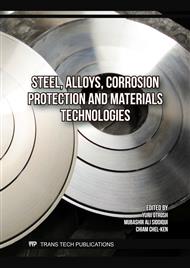[1]
V. Bezhan, V. Zhytarenko, O. Yakovleva, O. Ostapenko, M. Khmelniuk, Energy audit for complex energy system simulated using TRNSYS software. Energy Engineering and Control Systems. 6 1 (2020) 33–42
DOI: 10.23939/jeecs2020.01.033
Google Scholar
[2]
T. Zhang, Methods of Improvingthe Efficiency of Thermal Power Plants. Journal of Physics: Conference Series. 1449 (2020) 012001.
DOI: 10.1088/1742-6596/1449/1/012001
Google Scholar
[3]
S.Wi, J.H. Park, Y.U. Kim, S. Yang, S. Kim, Thermal, hygric, and environmental performance evaluation of thermal insulation materials for their sustainable utilization in buildings. Environmental Pollution. 272 (2021) 116033
DOI: 10.1016/j.envpol.2020.116033
Google Scholar
[4]
Yihan Xue, Review of Thermal Insulation Materials for Pipelines. Scholars Journal of Engineering and Technology (SJET). 4 (5) (2016) 258–260 https://saspublishers.com/media/articles/SJET45258-260.pdf
Google Scholar
[5]
M.M., Semerak, T.I. Rymar, T.Y. Hlova, Mathematical Modeling of the Thermal Stress State in a Connection Unit of the Coil Shank End with High-Pressure Heater HP-2500-97 Collector. Mater Sci.. 58 (2023) 474–479
DOI: 10.1007/s11003-023-00687-1
Google Scholar
[6]
I. Garrido, S. Lagüela, R. Otero, P. Arias. Thermographic methodologies used in infrastructure inspection: A review-Post-processing procedures. Applied Energy. 266 (2020) 114857
DOI: 10.1016/j.apenergy.2020.114857
Google Scholar
[7]
T. Pflug, B. Bueno, M. Siroux, T. E. Kuhn, Potential analysis of a new removable insulation system, Energy and Buildings. 154 (2017) 391–403
DOI: 10.1016/j.enbuild.2017.08.033
Google Scholar
[8]
Benjamin Park, Wil V. Srubar, Moncef Krarti, Energy performance analysis of variable thermal resistance envelopes in residential buildings, Energy and Buildings. 103 (2015) 317–325
DOI: 10.1016/j.enbuild.2015.06.061
Google Scholar
[9]
Rules of Occupational Safety During the Operation of Equipment Operating Under Pressure [Pravyla okhorony pratsi pid chas ekspluatatsii obladnannia, shcho pratsiuie pid tyskom], 43. [in Ukrainian]
Google Scholar
[10]
T.H. Hryshchenko, L.V. Dekusha, et al., Determination of Heat Flows Through Enclosing Structures: Methodology M00013184.5.023–01. K.: LOGOS, 2002, 131 p. [in Ukrainian]
Google Scholar
[11]
I.O. Mikulonok, Design of Thermal Insulation for Equipment and Pipelines: Textbook. 2nd ed., revised and supplemented. K. : NTUU «KPI», 2013, 188 p. [in Ukrainian]
Google Scholar
[12]
T. Rymar, A. Malysheva, Intensification of heat transfer during steam condensation in process condenser of NPP unit cooling system. Energy Engineering and Control Systems. 10 (1) (2024) 1–6
DOI: 10.23939/jeecs2024.01.001
Google Scholar


